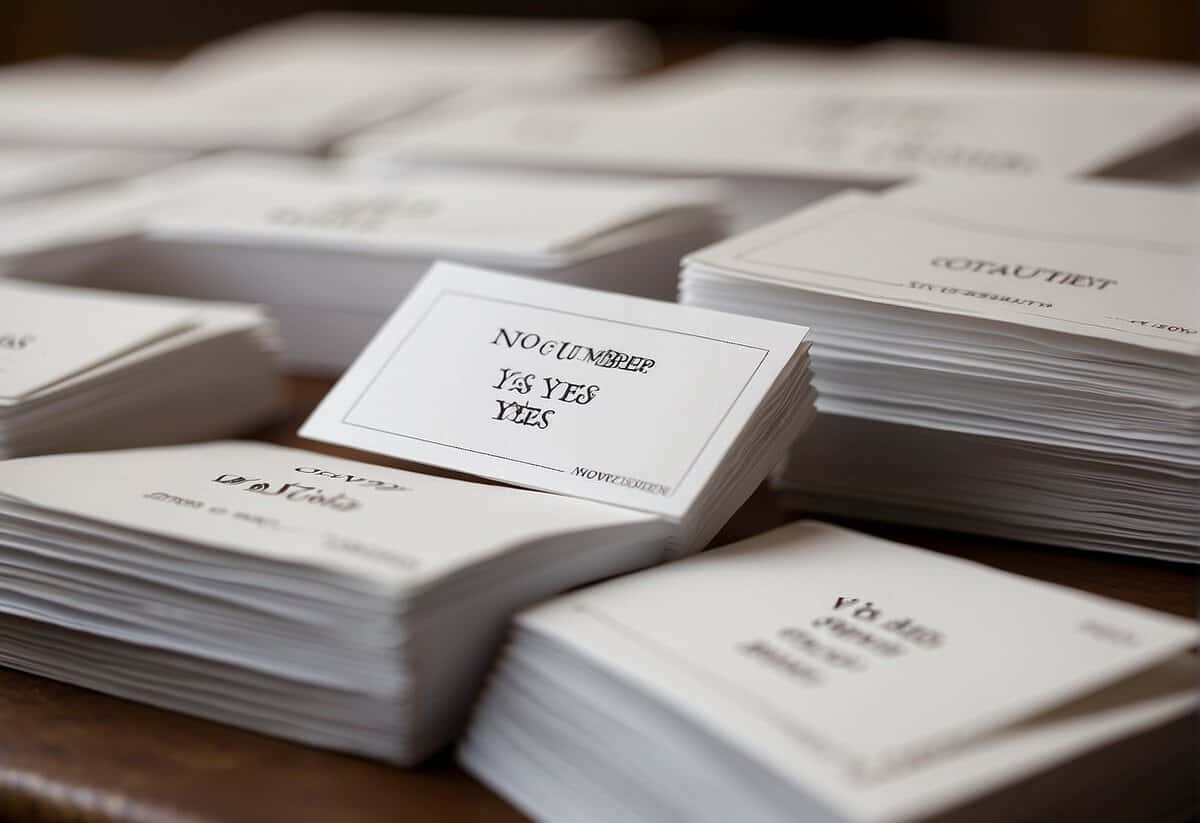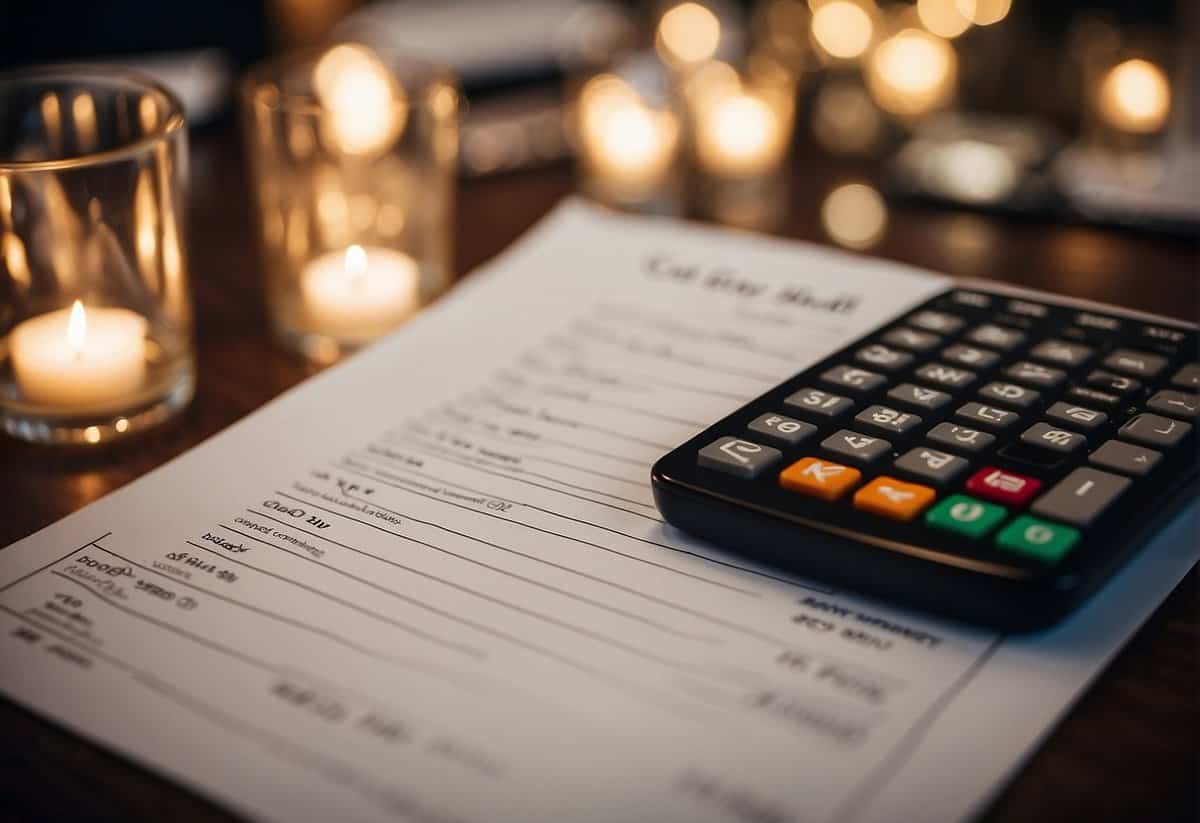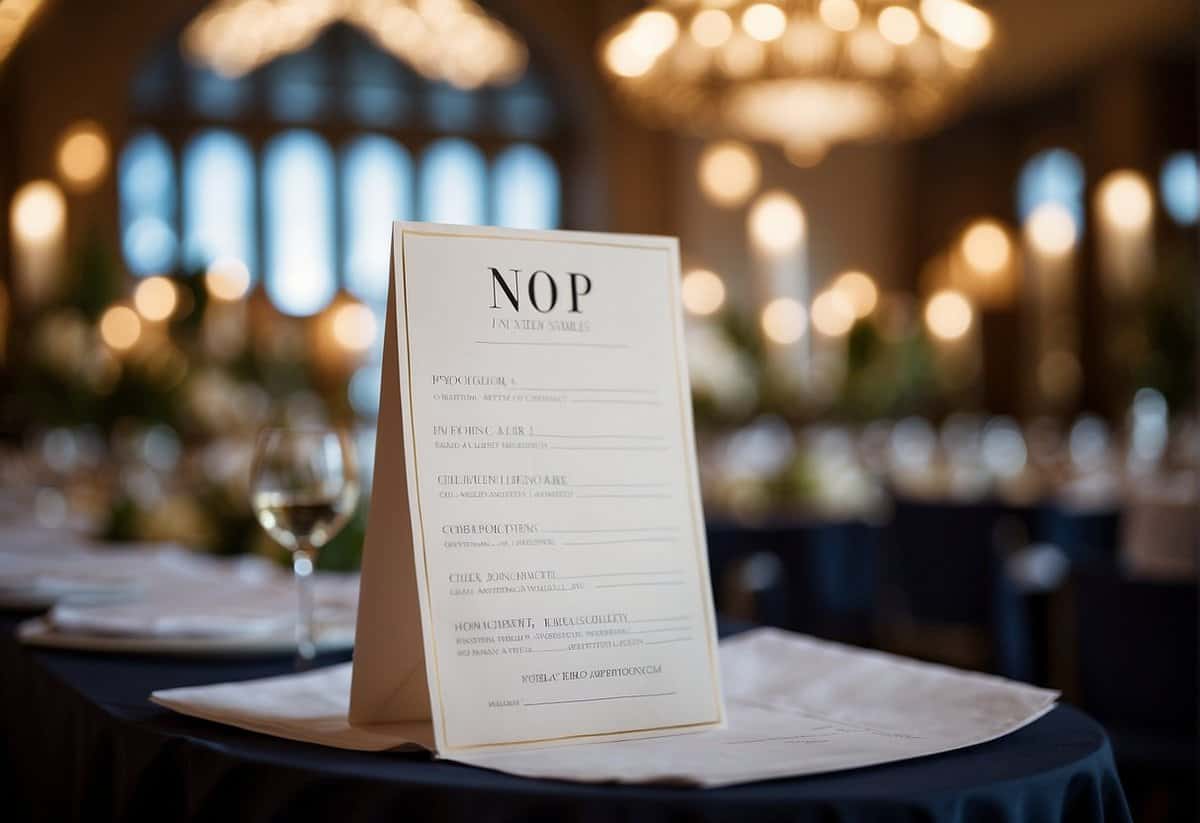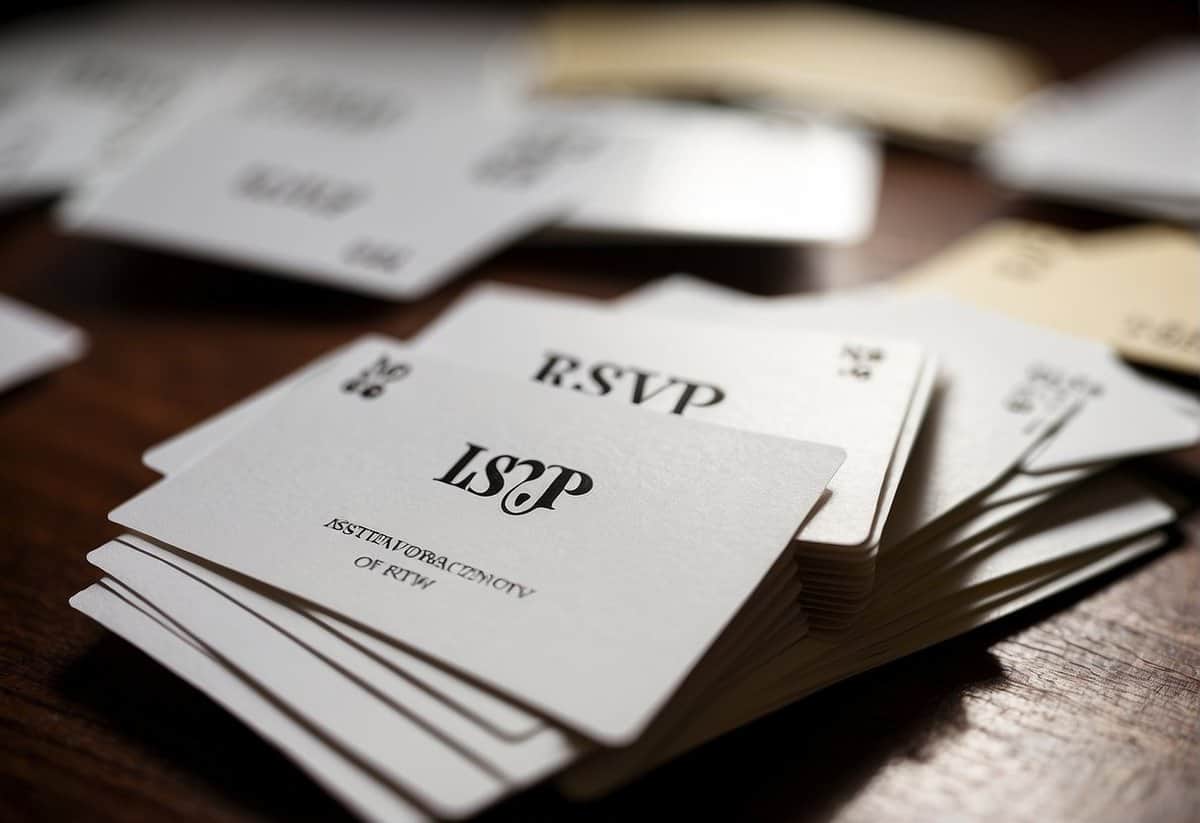How Many Guests RSVP No? Understanding Wedding Invitation Responses
When planning your special day, one of the most crucial considerations is how many guests will accept your wedding invitation. It helps with everything from venue selection to catering and budgeting. Historically, a certain percentage of invitees are expected to decline, which can vary widely depending on several factors such as location, date, and personal circumstances.

Understanding the typical rates at which guests RSVP ‘no’ can provide a realistic outlook for your event planning. Traditionally, experts in wedding planning have observed that on average, about 20% of guests tend to send regrets. Nevertheless, these rates have fluctuated over the years and may also diverge based on the specific nature of the wedding or the demographics of the guest list.
Key Takeaways
- Accurately predicting RSVP ‘no’ rates aids in effective wedding planning.
- Knowledge of RSVP etiquette is essential for managing guest list responses.
- Anticipation of guest attendance impacts budget and logistical arrangements.
Understanding RSVP and Guest List Management

When planning an event such as a wedding, managing your guest list and understanding RSVPs are crucial to predicting attendance. Your wedding invitations are the first clue guests will receive about your special day, and the included RSVP cards or online RSVP will help you gather who can attend.
The Basics of RSVP
RSVP stands for ‘répondez s’il vous plaît,’ which is French for ‘please reply.’ This is a way for your guests to confirm whether they’ll be attending your event. When sending out wedding invitations, it’s essential to include a method for your invitees—family and friends—to respond with their attendance intention. Here’s a simple breakdown:
- Invitation Sent: This is the official announcement of your event and should include all the necessary details like the date, time, and location.
- RSVP Request: Accompanying your invitation, this is the formal request for guests to let you know if they can attend.
- Guest List: A strategic plan helps you track who has been invited and who has confirmed they will attend. It often includes family members and friends.
- Response Collection: Whether through traditional mailed RSVP cards or an online platform, responses should be easy to submit and track.
- Follow-up: For those who haven’t responded as your event nears, a friendly follow-up can ensure you have an accurate headcount.
Remember that a typical response rate for wedding guests varies. Depending on several factors, around 83% to 85% of invitees tend to respond positively. However, you might see numbers dip as low as 60%, depending on the circumstances of your wedding. Managing these details effectively will contribute greatly to the smooth planning of your wedding.
Etiquette and Handling ‘No’ Responses

When you receive a ‘No’ RSVP, it’s important to handle it with grace and understanding. Here’s how to navigate the delicate etiquette involved with declined invitations.
Reasons for Declining
Travel: Guests may decline due to the distance they would have to travel. It’s not uncommon for travel costs or the time required to journey to an event to be a deciding factor in their ability to attend.
Scheduling Conflict: Your invitees might have pre-existing commitments that prevent them from attending. Whether it’s work, a prior engagement, or another event, scheduling conflicts are a common and justifiable reason.
Distant Relationship: Sometimes, the relationship between you and the guest isn’t close enough to warrant their attendance, which is a valid reason for a polite decline.
Illness: Personal or family illness can lead to a decline. Respect their privacy and wish them a speedy recovery or offer your support.
Death in the Family: A recent loss in the family is a deeply personal and valid reason for not attending. Offer your condolences and understanding.
Etiquette Expert: Consult an etiquette expert for advice if you’re unsure how to respond to a ‘No’ RSVP. They can provide tailored guidance for your situation.
COVID: The pandemic has introduced new reasons for declining an RSVP, such as concerns over COVID-19. Accept their decision with empathy and prioritize health and safety.
Remember, when you receive a ‘No’ response, it’s important to respond with kindness and maintain the relationship for future interactions. It’s part of the RSVP etiquette and shows your understanding and respect for their situation.
Wedding Planning and Budget Considerations
When you’re deep in the midst of wedding planning, understanding the relationship between guest responses and your budget can help you allocate funds more effectively and avoid unnecessary spending.

Impact of Guest Responses on Budget
The number of guests who RSVP ‘yes’ directly influences several cost factors for your wedding. Venue capacity might determine price tiers, as some venues charge on a per-person basis. Your caterer will also need an accurate headcount to determine the amount of food needed, and remember, every plate counts towards your total cost.
Consider the rentals: tables, chairs, and even the size of the dance floor must match guest quantity to ensure comfort without wasting resources. A more intimate gathering could lead to savings on these items.
Here’s a quick breakdown of potential changes in costs based on guest responses:
Catering: Typically the largest expense, it adjusts with guest count.
- Budget Tip: Some caterers offer discounts for children or vendors.
Venue: Size requirements may shift with the final headcount, impacting the price.
- Budget Tip: If RSVPs are lower, you might downsize the venue or negotiate better rates.
Rentals: Tables, chairs, linens, and dinnerware will vary in quantity.
- Budget Tip: Finalize these numbers close to your date to avoid excess fees.
Beverages: Both alcoholic and non-alcoholic drinks will be consumed based on the number of attendees.
- Budget Tip: Consider a consumption bar rather than an open bar to save on unopened bottles.
Every ‘no’ RSVP can free up a portion of your wedding budget allowing you to redirect finances to other wedding elements or save it for your future together. Keep a close eye on your guest list and RSVPs to maintain your finances in check and ensure a wonderful experience for everyone involved.
Logistics for Out-of-Town and Special Cases

When you’re planning a wedding, managing out-of-town guests can be a delicate balancing act. Ensuring their comfort often involves special attention to travel, accommodations, and other unique needs.
Accommodating Out-of-Town Guests
Travel Arrangements: If you’re hosting a destination wedding or expecting numerous guests from afar, consider arranging group travel. This could mean reserving blocks of hotel rooms or even coordinating discounted flights. It’s particularly appreciated if your wedding is taking place during a busy travel season or amidst pandemic concerns. You might want to provide information on safe travel practices and updates on any vaccine requirements.
Childcare Services: Recognize that out-of-town guests may need help with childcare. You might arrange for trusted childcare providers to be available during your wedding events. This gesture not only shows that you value their presence but also that you understand the logistics of traveling with children.
Scheduled Activities: To make their stay memorable, organize special activities for these guests. Think guided tours, welcoming receptions, or a post-wedding brunch. This offers them more than just a celebration to attend — it becomes a mini-holiday.
Communicating Details: Keep your guests in the loop with a detailed itinerary. Send this well in advance and include contact information for key staff handling various aspects of guest logistics, such as travel coordinators or hotel liaisons.
Remember, guests coming from out of town are making an extra effort to celebrate with you. By managing these logistics effectively, you’re showing gratitude and ensuring their experience is as seamless and enjoyable as possible.
Frequently Asked Questions

When you’re sending out your wedding invitations, the RSVP responses play a crucial role in your planning process. Knowing how many guests might decline can help in managing expectations and logistics.
What is the typical percentage of guests who decline a wedding invitation?
The percentage of guests who RSVP ‘no’ can vary, but it’s common to see a positive response rate between 60% to 85%, with factors like date and location playing significant roles.
How can you calculate the estimated turnout after sending wedding invitations?
To estimate turnout, start with the typical response rate and adjust according to the specifics of your event. For example, if you invite 100 guests and expect an 80% attendance rate, plan for approximately 80 guests.
What factors influence the average number of guests not attending a wedding?
Factors include the wedding’s location, date, how far in advance invitations are sent, and the personal circumstances of your guests, such as travel requirements or scheduling conflicts.
Can you guide me on how to politely request RSVP confirmations for my wedding?
Sure, use clear language on your invites asking guests to confirm their attendance by a specific date, providing a simple way to respond ‘yes’ or ‘no,’ as advised by WeddingCheckpoint.
What’s the expected attendance rate for a destination wedding?
For a destination wedding, the attendance rate is often lower due to travel costs and commitments, so you might expect around 60-70% of invited guests to attend.
How do I effectively manage my guest list based on anticipated RSVP responses?
Create your guest list with tiers and send invitations in waves. Once you receive responses from the first set, if declines free up space, you can then invite more guests from the next group.
